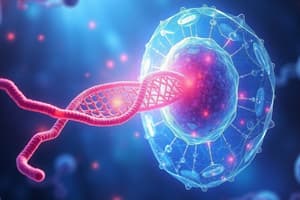Podcast
Questions and Answers
How does the genome differ functionally from a gene?
How does the genome differ functionally from a gene?
The genome consists of the entire set of hereditary information and chromosomes, while a gene is a specific sequence within the genome that codes for a single protein.
What is meant by the term 'genetic locus'?
What is meant by the term 'genetic locus'?
A genetic locus refers to the specific physical location of a gene on a chromosome.
Explain the relationship between genes and proteins in an organism.
Explain the relationship between genes and proteins in an organism.
Genes contain the instructions for synthesizing proteins, serving as templates for the production of these vital biological molecules.
Why might the number of genes vary significantly between different organisms?
Why might the number of genes vary significantly between different organisms?
What role does DNA sequence play in the function of the genome?
What role does DNA sequence play in the function of the genome?
What is the 'C-value enigma' in regards to genome size and complexity?
What is the 'C-value enigma' in regards to genome size and complexity?
How are pseudogenes different from functional genes?
How are pseudogenes different from functional genes?
Why are non-coding functional RNA genes significant within the genome?
Why are non-coding functional RNA genes significant within the genome?
What role do cis and trans regulatory elements play in gene expression?
What role do cis and trans regulatory elements play in gene expression?
In what way can non-coding DNA sequences contribute to diseases?
In what way can non-coding DNA sequences contribute to diseases?
Flashcards are hidden until you start studying
Study Notes
Genome and Genes
- A genome encompasses the complete set of chromosomes, including all DNA molecules, encoding genetic information.
- Genes, the functional units of the genome, determine specific traits and occupy defined locations on chromosomes, known as genetic loci.
- Gene numbers vary widely among organisms, from approximately 500 in mycoplasma to about 40,000 in humans.
- Non-coding DNA, comprising considerable portions of eukaryotic genomes, includes functional RNA genes, regulatory elements, introns, and pseudogenes.
- The C-value paradox refers to inconsistencies between genome size and organismal complexity, exemplified by the small genome of pufferfish, contrasting with human gene count.
Types of Non-Coding DNA
- Non-coding functional RNA genes: Include rRNA, tRNA, and microRNAs, which are essential for various cellular functions but do not encode proteins.
- Cis and Trans regulatory elements: Control gene expression; cis elements (promoters, enhancers) and trans elements (repressors, operators) direct transcription and regulatory activities.
- Introns: Non-coding regions interspersed within genes, excluded from mRNA during processing.
- Pseudogenes: Non-functional gene remnants due to mutations, often termed genomic fossils.
- Repetitive DNA and telomeres: Non-coding sequences at chromosome ends, with roles in chromosome protection and stability.
Functions of Non-Coding DNA
- Non-coding DNA plays crucial roles in regulating gene expression and chromosomal integrity.
- Certain non-coding variants are linked to diseases and are involved in the formation of regulatory RNAs, like microRNA and siRNA.
- Non-coding DNA contributes to chromosomal structures, centromere operations, and meiosis.
Prokaryotic Gene Organization
- Prokaryotic genomes, primarily bacterial, are compactly organized within a nucleoid, containing about 80% DNA.
- DNA is structured into domains, with nearly 100 loops per genome, facilitating supercoiling and compactness.
- DNA is shielded by polyamines to minimize charge repulsion, enabling tight packing within small cellular volumes.
Eukaryotic Gene Organization
- Eukaryotic DNA is extensively packaged into chromatin and chromosomes, accommodating long DNA sequences within cell nuclei.
- Chromatin comprises DNA, proteins, and RNA, with histones being central to DNA organization.
- Five major histone classes (H1, H2A, H2B, H3, H4) participate in forming nucleosomes, the basic structural units of chromatin.
Nucleosomes and Higher-Order Structures
- Nucleosomes consist of histone cores and linker DNA, crucial for DNA compaction, typically repeating every 2,000 base pairs.
- Histone tails extend from nucleosomes, playing key roles in chromatin condensation and gene regulation through modifications like acetylation.
The 30-nm Fiber
- Nucleosomes organize into a 30-nm fiber, achieving significant DNA compaction over chromosomes while remaining accessible for replication and transcription.
- The structure and compaction can vary, influenced by the transcriptional activity of specific DNA regions.
Nuclear Scaffold and Loops
- Certain DNA regions associate with a nuclear scaffold, with scaffold-associated regions separated by loops containing related genes, facilitating functional organization within the nucleus.
Studying That Suits You
Use AI to generate personalized quizzes and flashcards to suit your learning preferences.




